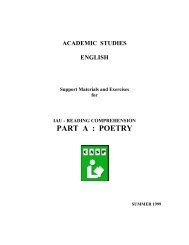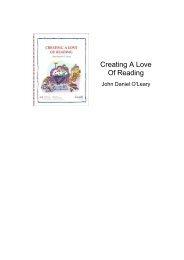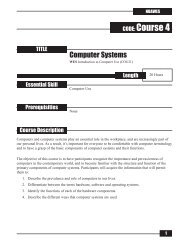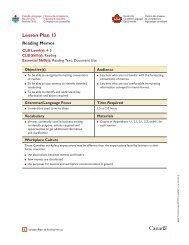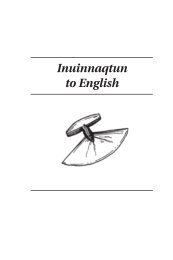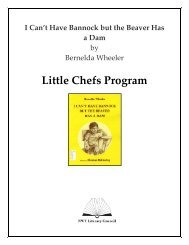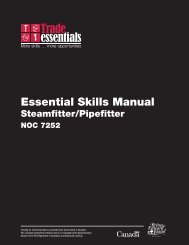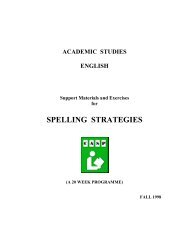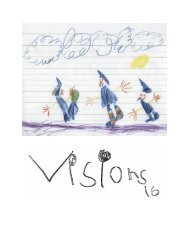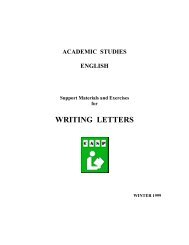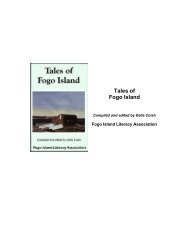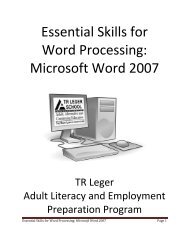Integrating Essential Skills into Training - National Adult Literacy ...
Integrating Essential Skills into Training - National Adult Literacy ...
Integrating Essential Skills into Training - National Adult Literacy ...
You also want an ePaper? Increase the reach of your titles
YUMPU automatically turns print PDFs into web optimized ePapers that Google loves.
WW Report & Resource Guide <strong>Integrating</strong> <strong>Essential</strong> <strong>Skills</strong> <strong>into</strong> <strong>Training</strong> Materials<br />
Workshop 3: <strong>Integrating</strong> <strong>Essential</strong> <strong>Skills</strong> <strong>into</strong> Aboriginal preapprenticeship<br />
training<br />
Hildy Hanson<br />
Hildy began by providing a brief overview of the essential skills programs Keyano<br />
College has developed in partnership with Syncrude Canada Ltd. after which she<br />
described the successful integration of these essential skills programs <strong>into</strong> aboriginal<br />
pre-apprenticeship programs.<br />
Keyano has developed three essential skills programs for Syncrude Canada. The reading<br />
program, Effective Reading in Context (ERIC), was the first workplace reading program<br />
in Canada. Syncrude initially identified a need for a workplace reading program when it<br />
was putting a group of employees through some testing to identify leadership abilities.<br />
After the curriculum was developed and received the advisory group’s approval, it was<br />
piloted and the rest is history. The core curriculum remains the same, but the program<br />
has gone through many adaptations since 1988. The program name “Reading in<br />
Context” directs the program. The program is always delivered in context of each<br />
participant’s need and in context of each particular delivery worksite. The readings are<br />
constantly changing.<br />
The most radical change to the program occurred two years ago when an adaptation<br />
was completed for the Northern Lights Health Region. This is when the program shifted<br />
its focus to Safety and Workplace Reading.<br />
What reading has to be managed in the workplace? How many reading tasks influence<br />
or are influenced by safety?<br />
Without fail, when these questions are asked of people employed in the oil sands<br />
industry, the answer is all. Every reading task required on the worksite has some<br />
impact on workplace safety. Incidents cause injury, loss of lives and loss of production.<br />
Safety performance and reading are human activities controlled by the choices made by<br />
the individual. Workplace Failure is classified as human failure when procedures are not<br />
followed. When reading a hazard sign on a construction site, it doesn’t matter whether<br />
an employee reads at a Grade 7 level or whether the employee has a college degree,<br />
he/she must be ‘in the moment’ at the time and must read with 100% accuracy.<br />
Reading is a safety issue; the score you got on your last reading test is not recorded in<br />
the incident report. BUT your attention level can be recorded on the safety report!<br />
Hildy used a photo of a very large piece of equipment called a coker to illustrate one<br />
reason that Safety and Workplace Reading is so important in the oil sands industry. As<br />
she explained, it is normal for millions of dollars worth of new equipment to move north<br />
through the city every week. The installation of a coker is probably worth over 150<br />
million dollars and it is just one piece of equipment that is going <strong>into</strong> a project worth<br />
over 2 billion dollars. Furthermore, this project is just one of the 80 billion dollars worth<br />
of projects over the next 15 years in the Wood Buffalo region. Each one of these<br />
projects has thousands of procedures and instructions. Each procedure has to be



